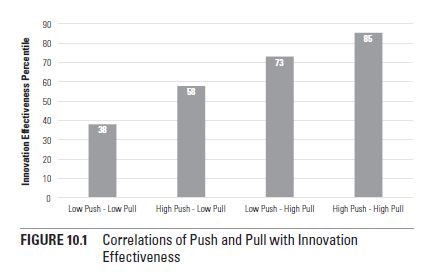Note: The following article was adapted by the authors from their new book, Speed: How Leaders Accelerate Successful Execution.
The number one behavior tied to innovation is the willingness to change. We can all probably come up with a variety of activities that we continue to do even though there is a faster, more efficient way. Change takes energy, discipline, and often a willingness to do something we have never done before.
The people who are most likely to be innovative are those who are not satisfied with good performance, but are constantly looking for superior performance. It is amazing how much mediocrity we can all put up with in our lives. Possibly it is the combination of traffic jams, the lines in stores, and the bureaucracy that develops at work that influences expectations that everything is going to be slow and difficult. It is easy for people to simply go with the flow and not look for efficiency or faster options.
We discovered in our research that those people who were most innovative were constantly looking for time-saving, efficient methods and options.
Suppose your organization needed to jump-start efforts around improving innovation in the organization. What leadership behaviors would yield the most innovation?
Two possible methods for leaders are to push harder and to pull harder.
Push harder
- Leaders set deadlines for innovations to be created.
- Hold individuals accountable for improvements in innovation.
- Regularly follow up with individuals to ensure targets will be met.
- Push people hard to deliver on their commitments.
Pull harder
- Leaders generate excitement and interest about what innovations could do for the organization.
- Find ways to energize colleagues to innovate more.
- Celebrate any success in innovation.
Push or Pull: Which is better
Both approaches seem helpful. To test which is most important, we looked at data from over 57,000 leaders. We identified those leaders who were in the top quartile on both push and pull. We then looked at their ratings of effectiveness in creating an innovative environment in their teams and the organization.
 What we found is that leaders who were below the top quartile on both push and pull scored at the 38th percentile on innovation. Leaders who were at the top quartile on push, but not at pull, improved to the 58th percentile, while those who were in the top quartile on pull but not push were in the 73rd percentile.
What we found is that leaders who were below the top quartile on both push and pull scored at the 38th percentile on innovation. Leaders who were at the top quartile on push, but not at pull, improved to the 58th percentile, while those who were in the top quartile on pull but not push were in the 73rd percentile.
Clearly, our data confirms that when it comes to innovation, pull yields more innovation than push. It is interesting, however, to see the combined effect of both push and pull on innovation. Leaders in the top quartile on both skills were rated at the 85th percentile on innovation.
What these results reveal is that while pull is most helpful at generating innovation, leaders who also held others accountable, set deadlines, and pushed hard were able to achieve even better results.
What pull leaders do
Looking at the leaders who were in the top quartile on both innovation and their ability to pull, we did a t-test to determine the key behaviors that helped them to create this innovation environment. We contrasted their results to those of all other leaders in our database, and then sorted out the behaviors that showed the highest significant differences.
These behaviors have a high probability of increasing your effectiveness at pulling up innovation in your team.
They set stretch goals that required people to do the impossible.
It’s interesting to see the effect of stretch goals. Asking people to increase production by 10% can be accomplished by people simply working longer and harder, but asking for a 50% increase forces people to rethink the problem. Stretch goals force team members to rethink the entire process and begin to imagine innovative approaches to accomplishing objectives.
They provided a clear sense of direction and purpose.
While not micromanaging the process, we found these leaders did provide clear direction and purpose. They communicated often about the desired direction and what was needed. They also helped people connect their individual responsibilities to the overall business objectives. Some people worry about over-communication, but our research reveals that for most leaders the problem is that they don’t communicate enough.
They painted the long- term vision for where the organization needs to go.
In addition to what needs to be done today, these leaders had the long view of where the organization needed to be in the future. That long view of an aspirational goal and objective keeps people on track, and it provides them with a sense of destination about where they need to go.
They turned on a dime.
The road to innovation is full of potholes and wrong turns. These leaders were very skilled at recognizing problems and changing direction quickly. They encouraged everyone to learn from mistakes and then move forward. They also provided support for people who made mistakes. Team members felt that their leader had their backs and would not throw them under the bus.
They kept the focus on the customer: It is so easy for innovations to become pet projects that are of interest and use to the organization, but of little value to the customers. These exceptional leaders understood the current and future needs of the customers and looked for opportunities to have team members interact and interface with customers to increase their understanding and commitment.
They sold the new idea and approach to others: Too often people believe that the value of a new, innovative approach will be so obvious to others that it really does not need to be sold. Often this is where innovation fails because others in the organization do not see the value.
